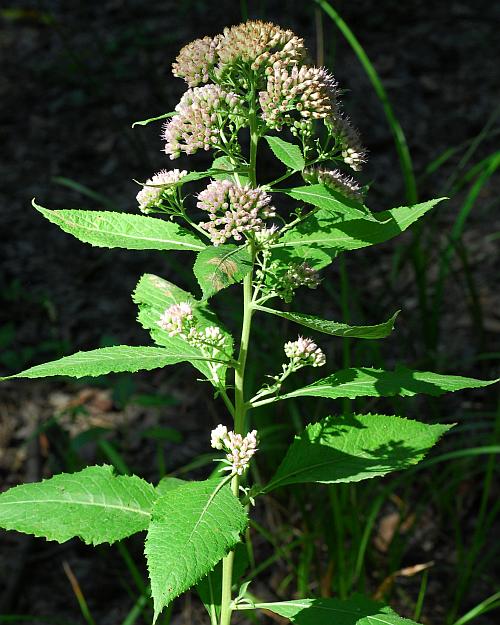Pluchea camphorata (L.) DC.
Stinkweed

Native
CC = 4
CW = -3
MOC = 23
© SRTurner
Pluchea camphorata (L.) DC.Stinkweed | |
 |
Native CC = 4 CW = -3 MOC = 23 |
© SRTurner |
|
Family - Asteraceae/Plucheeae Habit - Annual or short-lived perennial forb, fibrous-rooted and sometimes with short rhizomes. Stem - Ascending to erect, to 1 m, densely and minutely hairy toward the tip, sometimes nearly glabrous toward the base, occasionally also with sparse, longer hairs.
Leaves - Alternate, simple, short petiolate to sessile but not clasping. Blades 4-15 cm long, lanceolate to ovate or elliptic, angled or tapered at the base, angled or tapered to a sharply pointed tip, the margins with widely spaced teeth or more or less scalloped, rarely nearly entire, both surfaces with sparse to moderate, sessile, spherical glands, the undersurface also minutely hairy.
Inflorescence - Dense paniculate clusters of flowering heads at branch tips, usually rounded in profile.
Heads - Discoid, 5-9 mm in diameter. Involucre 4-6 mm long, the outer bracts triangular-ovate, angled to tapered at the tip, often pinkish- or purplish-tinged, at least toward the tip, the outer surface with sessile, spherical glands and often also minute hairs.
Flowers - Ray florets absent. Disk corollas 3-6 mm long, pink to pinkish purple. Inner florets few, usually functionally staminate. Outer florets more numerous, pistillate. Pappus in a ring of capillary bristles 3-5 mm long, white or pinkish-tinged.
Fruits - Achenes 0.6-1.0 mm long, cylindrical, with 4-6 ribs, not winged, not beaked, pinkish tan, hairy, at least along the ribs. Flowering - August - October. Habitat - Bottomland forests, swamps, sloughs, streambanks, pond margins, bottomland prairies, marshes, ditches, roadsides. Origin - Native to the U.S. Lookalikes - P. foetida. Other info. - This interesting and distinctive species is found mostly in the southern quarter of the state. This is near the northwestern extent of the plant's natural range, which extends throughout most of the southeastern U.S. It is easy to recognize by the strong and distinctive odor emitted by crushed foliage. Some have described the aroma as akin to camphor, and in fact the specific epithet camphorata means "camphor-scented." However, individuals actually familiar with the aroma of camphor will find very little similarity to this plant's smell, which might be better described as fetid. A single plant in my press was sufficient to imbue the entire room with this disagreeable stench, which persisted for some time. The species can be distinguished from its lookalike by its petiolate leaves. Those of P. foetida are sessile and clasp the stem. Photographs taken off Moores Mill Rd., Auburn, AL., 8-26-04 (DETenaglia); also at Otter Slough Conservation Area, Stoddard County, MO, 8-19-2013, and Big Cane Conservation Area, Butler County, MO, 9-7-2019 (SRTurner). |